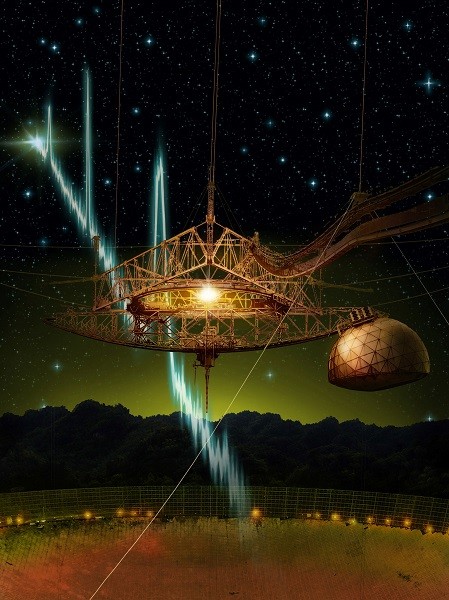By Ana Verayo, | January 05, 2017

From space, a sequence of millisecond-duration radio flashes are racing towards the dish, where they will be reflected and detected by the radio receivers. (Danielle Futselaar/USRA)
Astronomers have finally identified the source of a mysterious signal originating from the deepest regions of the universe. These repeating signals are known as Fast Radio Bursts (FRBs). They have only been detected 18 times since their discovery in 2007.
Like Us on Facebook
These mysterious signals have been an enigma to scientists; nobody knows their origins or why and how they are emitted. One theory about the signals claims they are powerful energy jets from massive stars or supermassive black holes, others say it is a beacon from a highly advanced alien civilization.
More specifically, FRBs are powerful signals made from radio waves that last no longer than a millisecond.
The first ever FRB was detected in 2007 by the CSIRO (Commonwealth Scientific and Industrial Research Organization) Parkes radio telescope. Since then, only 17 have been heard as they occur so fast.
The origin of FRB 121102 has finally been revealed in this study. It is also the only repeating signal from the 17 ever detected. This signal was detected by the Arecibo radio telescope in Arecibo, Puerto Rico in 2012, churning out at irregular intervals.
A team from the National Radio Astronomy Observatory's Very Large Telescope in New Mexico and the European VLBI Network (EVN) have monitored this FRB. Between late August to mid-September last year, the VLA detected nine bursts from FRB 121102. Scientists identified the real source of the signal to be a faint yet consistent galaxy. The results of the study were published in the journal, Nature this week.
Four more bursts were detected in late September last year by the EVN and the Arecibo radio telescope, further narrowing down the location of this galaxy source. The results were published in Astrophysical Journal Letters.
With data from the powerful radio telescope arrays of Arecibo, VLT, and EVN, astronomers have been able to determine the distance of this galaxy, at more than 3 billion light years away. The results of the study has been detailed in the Astrophysical Journal Letters.
According to the lead authors of this study, Netherlands Institute for Radio Astronomy's Cees Bassa and Shriharsh Tendulkar of McGill University in Canada, the source of the signal was traced back to this really small, star forming dwarf system. Scientists say this is odd since dwarf galaxies host fewer stars than most and further research is needed to identify the exact mechanism of the FRBs.
-
Use of Coronavirus Pandemic Drones Raises Privacy Concerns: Drones Spread Fear, Local Officials Say

-
Coronavirus Hampers The Delivery Of Lockheed Martin F-35 Stealth Fighters For 2020

-
Instagram Speeds Up Plans to Add Account Memorialization Feature Due to COVID-19 Deaths

-
NASA: Perseverance Plans to Bring 'Mars Rock' to Earth in 2031

-
600 Dead And 3,000 In The Hospital as Iranians Believed Drinking High-Concentrations of Alcohol Can Cure The Coronavirus

-
600 Dead And 3,000 In The Hospital as Iranians Believed Drinking High-Concentrations of Alcohol Can Cure The Coronavirus

-
COVID-19: Doctors, Nurses Use Virtual Reality to Learn New Skills in Treating Coronavirus Patients








